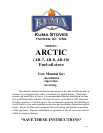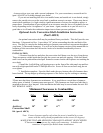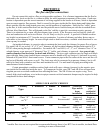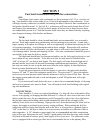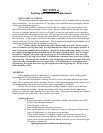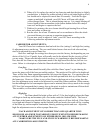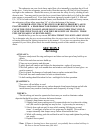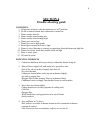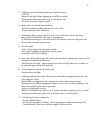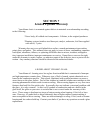
SECTION 2
The flue and flue connections
Do not connect this unit to a flue servicing another appliance. It is of utmost importance that the flue be
dedicated to the Arctic as the flue is, without a doubt, the most important component of the system. Good com-
bustion is dependent upon the correct amount of air being supplied to the burner at all times, which is dependent
upon a correct negative flue pressure. Draft is caused by the gases inside the flue being hotter and lighter than
the air outside, thus the rising heated gases carry out the products of combustion. Since the flue “sucks” gases
up the flue, it is this suction that draws air into the pedestal area to feed the burn pot with the air needed for an
efficient, blue-flame burn. This will depend on the flue’s ability to provide a consistent negative pressure.
There is no substitute for a warm, efficient chimney/pipe system. If the flue gases cool too quickly, draft will
slow and combustion will not be as efficient. Do not skimp on the flue system. A good rule of thumb on chim-
ney height is a minimum of 12’ from the stove to termination. Location of chimney and other factors may re-
quire more or less chimney height. In areas of high winds or draft inversions, a suitable wind-directional or vac-
uum cap may be needed.
An insulated chimney is a must in order to maintain the heat inside the chimney for proper flow of gases.
For model AR-10, use a class “A”,4”,5” or 6” diameter, all-fuel insulated chimney that has been tested to U.L.
HT103 when passing through combustibles. For models AR-7 and AR-8, a 4”, 5”, or 6” diameter Class “A” in-
sulated chimney or an approved 4” diameter Class “L” (pellet vent) chimney is approved. As a general rule,
smaller diameter flues are better for draft and efficiency. The stove pipe connector may be single-wall black
pipe with tight fitting joints (mobile home connectors must be double-wall, see Section 1), and must be securely
fastened at all joints with 3 sheet metal screws. Fasten connector pipe to the flue collar on the stove and the ceil-
ing box/wall thimble with screws as well. The Arctic may also be connected to a masonry chimney, but it will
need to be lined with a stainless steel liner and insulated as well. Use and install all piping according to the
manufacturers listed clearances.
Certain atmospheric conditions such as high winds will cause a change (increase) in the negative pres-
sure inside the flue and thus inside the stove. To compensate for this, your AR-7 and AR-8 has an upper burn
ring that prevents over-draft conditions from affecting the burn. The AR-10 does not require a ring. In ex-
tremely high wind conditions, a tee in the stovepipe connector with a barometric damper may be required to help
compensate for these draft changes.
SIZING YOUR ARCTIC CHIMNEY
*smaller flue sizes are not required but recommended because there is less BTU loss in smaller, insulated flues
resulting in a more efficient draft.
Model: Chimney
Type:
4” diameter 5” diame-
ter
6” diameter
AR-7
Class “A”
or “L”
Recommended
OK
Not
Recommended*
AR-8
Class “A”
or “L”
Recommended
OK
Not
Recommended*
AR-10 Class “A”
only
Recommended
OK OK
Connector
Pipe: mobile
home
installation
Approved
double wall
only.
Approved
double wall
only.
Approved
double wall
only.
Connector
pipe:
residential
installation
Single or
double wall
connectors
Single or
double wall
connectors
Single or
double wall
connectors
3



